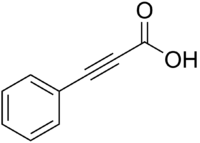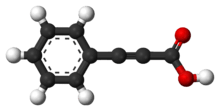Phenylpropiolic acid
 | |
 | |
| Names | |
|---|---|
| IUPAC name
Phenylpropynoic acid | |
| Other names
Phenylpropiolic acid | |
| Identifiers | |
| 637-44-5 | |
| ChemSpider | 62682 |
| |
| Jmol-3D images | Image |
| PubChem | 69475 |
| |
| Properties | |
| C9H6O2 | |
| Molar mass | 146.14 g/mol |
| Melting point | 135 to 137 °C (275 to 279 °F; 408 to 410 K) |
| Except where noted otherwise, data is given for materials in their standard state (at 25 °C (77 °F), 100 kPa) | |
| | |
| Infobox references | |
Phenylpropiolic acid, C6H5CCCO2H, formed by the action of alcoholic potash on cinnamic acid dibromide, C6H5CHBrCHBrCO2H, crystallizes in long needles or prisms which melt at 136–137 °C. When heated with water to 120 °C, it yields phenylacetylene (C6H5CCH). Chromic acid oxidizes it to benzoic acid; zinc and acetic acid reduce it to cinnamic acid, C6H5CH=CHCO2H, whilst sodium amalgam reduces it to hydrocinnamic acid, C6H5CH2CH2CO2H. Ortho-nitrophenylpropiolic acid, NO2C6H4CCCO2H, prepared by the action of alcoholic potash on ortho-nitrocinnamic acid dibromide, crystallizes in needles which decompose when heated to 155–156 °C. It is readily converted into indigo.
![]() This article incorporates text from a publication now in the public domain: Chisholm, Hugh, ed. (1911). Encyclopædia Britannica (11th ed.). Cambridge University Press.
This article incorporates text from a publication now in the public domain: Chisholm, Hugh, ed. (1911). Encyclopædia Britannica (11th ed.). Cambridge University Press.